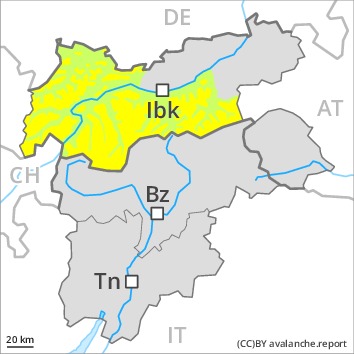
Danger level
 | 2200m
|
Avalanche Problem
 | | Wind-drifted snow |
|  | |  |
 | | Persistent weak layer |
|  | |  |
 | | Gliding snow |
|  | |  |

Fresh wind slabs especially adjacent to ridgelines and in gullies and bowls.
As a consequence of a moderate to strong wind from northwesterly directions, easily released wind slabs formed. The avalanche prone locations are to be found especially adjacent to ridgelines above approximately 2200 m. The number and size of avalanche prone locations will increase with altitude.
Avalanches can additionally in isolated cases be released in the weakly bonded old snow, in particular by large additional loads, especially at transitions from a shallow to a deep snowpack, when entering gullies and bowls for example. These avalanche prone locations are rare but are barely recognisable, even to the trained eye. Slight increase in danger of moist avalanches as a consequence of warming during the day and solar radiation. This applies especially in case of releases originating from very steep sunny starting zones.
Gliding avalanches can also occur at any time. Areas with glide cracks are to be avoided as far as possible.
Snowpack
dp.6: cold, loose snow and wind
dp.7: snow-poor zones in snow-rich surrounding
The fresh and older wind slabs are lying on unfavourable layers in particular on steep shady slopes above approximately 2200 m. Avalanche prone weak layers exist in the centre of the snowpack. As a consequence of mild temperatures and solar radiation a crust will form on the surface during the night, in particular on steep sunny slopes below approximately 2400 m.
Tendency
The weather conditions will bring about a slow stabilisation of the snow drift accumulations.

Danger level
 | 2000m
|
Avalanche Problem
 | | Wind-drifted snow |
|  | |  |
 | | Gliding snow |
|  | |  |
 | | Persistent weak layer |
|  | |  |

Wind slabs are to be evaluated with care and prudence.
The wind slabs are to be evaluated with care and prudence in particular in rocky terrain. They can be released easily or naturally in all aspects above the tree line. This applies in particular on very steep slopes, and adjacent to ridgelines.
Additionally in some places moist avalanches can also penetrate deep layers and reach medium size.
Slight increase in danger of dry and moist avalanches as a consequence of warming during the day and solar radiation. Areas with glide cracks are to be avoided as far as possible. An appreciable danger of gliding avalanches exists.
Ski touring and other off-piste activities, including snowshoe hiking, call for meticulous route selection.
Snowpack
dp.6: cold, loose snow and wind
The meteorological conditions facilitated a gradual strengthening of the near-surface layers in particular on sunny slopes. The fresh wind slabs remain for the foreseeable future prone to triggering in particular on steep shady slopes. This also applies in gullies and bowls below the tree line.
Faceted weak layers exist in the centre of the snowpack in particular above the tree line.
Towards its base, the snowpack is moist and its surface has a melt-freeze crust, in particular at low and intermediate altitudes.
Tendency
As a consequence of highly fluctuating temperatures the snow drift accumulations will stabilise during the next few days. A latent danger of gliding avalanches exists.

Danger level
 | 1800m
|
Avalanche Problem

Wind slabs require caution.
The fresh wind slabs are in some cases prone to triggering on steep shady slopes above approximately 1800 m. The avalanche prone locations are to be found in particular adjacent to ridgelines and in gullies and bowls. The avalanches are only small.
Weak layers in the old snowpack can be released in isolated cases and mostly by large additional loads, especially at high altitude in the Western Kitzbühel Alps.
Snowpack
dp.6: cold, loose snow and wind
The moderate wind will transport the snow. The small wind slabs are lying on soft layers on shady slopes above approximately 1800 m. As a consequence of rising temperatures the snow drift accumulations will stabilise during the next few days. Individual weak layers exist in the centre of the snowpack. At low altitude a little snow is lying.
Tendency
The weather conditions will bring about a slow stabilisation of the snow drift accumulations.

Danger level
 | 2400m
|
Avalanche Problem
 | | Wind-drifted snow |
|  | |  |
 | | Persistent weak layer |
|  | |  |

Wind slabs require caution.
The moderate wind will transport the snow. The small wind slabs can be released in particular on steep shady slopes above approximately 2400 m. The prevalence of avalanche prone locations and likelihood of triggering will increase with altitude.
Dry avalanches can additionally in isolated cases be released in the weakly bonded old snow, in particular by large additional loads, especially at transitions from a shallow to a deep snowpack, when entering gullies and bowls for example on very steep slopes. Such avalanche prone locations are to be found in particular on west to north to east facing aspects above approximately 2000 m.
Snowpack
dp.6: cold, loose snow and wind
dp.7: snow-poor zones in snow-rich surrounding
The fresh wind slabs are lying on soft layers in particular on shady slopes above approximately 2400 m.
Avalanche prone weak layers exist in the centre of the snowpack, especially between approximately 2000 and 2400 m on steep west, north and east facing slopes.
Tendency
The weather conditions will bring about a slow stabilisation of the snow drift accumulations.


















